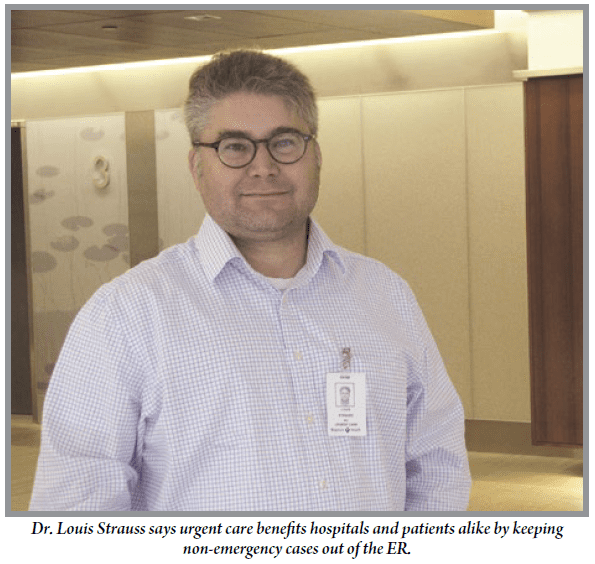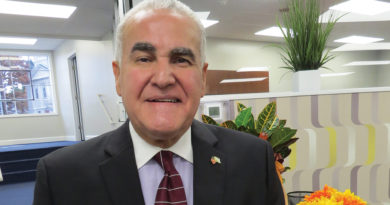Bridging the Gap – Hospitals See Urgent Care as Both Competition and Complementary
When Baystate Health got into the urgent-care business, Dr. Louis Strauss said, it was overseen by emergency doctors. But it soon became clear that those services were best aligned with primary care.
“We think it’s best to see your primary-care physician,” said Strauss, a family-medicine practitioner and medical director of Baystate Urgent Care, which has locations in Springfield, Northampton, and Belchertown. “They know you best; they have access to all your records. Ideally, you’ll see Dr. Smith for colds, checkups, cholesterol, hypertension, and he’s there for you. That is the ideal of primary care. However, it doesn’t work like that anymore. There is simply not enough primary-care physicians, and urgent care helps fill that gap.”
It’s bridging that gap nationwide, in fact. The number of urgent-care centers grew 4.4{06cf2b9696b159f874511d23dbc893eb1ac83014175ed30550cfff22781411e5} in the first half of this year alone, according to Merchant Medicine, which follows the urgent-care and retail-health market.
That makes sense, Strauss said, as patients come to understand the role of urgent-care practices, which treat patients for anything from colds and coughs to sprains and strains to broken bones, without dealing with the higher co-pays of an ER or, increasingly, the difficulty of getting a primary-care appointment.
“One way to look at urgent care is that it offloads the emergency room and keeps patients from ending up in the emergency room,” he told HCN. “But our focus is a little different. We opened urgent care to support our primary-care practices and help with overflow, which is an issue these days. And we help with after-hours and weekend issues.

“Preferably,” he went on, “a patient calls primary care and gets triaged by primary care — ‘oh, that’s really serious, you should go to the emergency room,’ or ‘maybe that’s something an urgent-care doctor can see,’ or ‘that can wait a few days, and we can fit you in.’ That seems to have worked well. In these days of accountable-care organizations, really, it’s best for everyone that we deliver the right care in the right setting.”
Dr. Rock Jean-Guillaume felt the same way when he and Dr. Richard Freniere, both emergency physicians at Baystate Wing Hospital, opened Urgent Care of Wilbraham a few years ago; they’ve since opened a second location in Holden.
“After we see a patient, we send the care documents to their primary-care physician,” Jean-Guillaume said. “We do not want to be their primary-care doctor. We bridge the gap in the care process for the patient. Family practices are burdened with large volumes of patients, so they’re often not able to see their patients in a timely manner. That’s why it’s important to have care facilities like ours that can serve as a bridge for this population.”
Both he and Strauss told HCN that, while hospitals do feel the impact of losing emergency patients to urgent care, the current hospital payment models are predicated on the goal of keeping patients out of hospitals and ERs, which is why more hospitals are competing with independent urgent-care owners by launching their own practices.
“We don’t want people with heart attacks showing up at urgent care; that gives everyone heartburn, so to speak. We want them in the emergency room,” Strauss said. “But accountable care is about appropriate care, not more care — about seeing a person in the right place at the right time and heading off unnecessary emergency-room visits. If we can see them in the office, it’s less expensive for everyone.
“If it’s 6 at night and you cut your finger and need stitches,” he went on, “it’s perfectly appropriate to end up in the emergency room, and often you will. But it’s also appropriate to go to urgent care, and we’ll evaluate it, treat it, and get you on your way. I would say 10{06cf2b9696b159f874511d23dbc893eb1ac83014175ed30550cfff22781411e5}, maybe 20{06cf2b9696b159f874511d23dbc893eb1ac83014175ed30550cfff22781411e5} of our patients would have ended up in the emergency room.”
Patients and Profit
A number of factors have contributed to the dramatic growth of urgent care across the U.S., and one obvious one is that they tend to be profitable. Health systems and insurance companies have taken notice, with many purchasing stakes in local urgent-care operators and national chains, according to Forbes.
“Baystate is taking a unique point of view, and other big hospital systems are doing this as well,” Strauss said. “The approach we’re taking is to provide better care for our patients, as opposed to the for-profit model of a lot of doctor-in-a-box places, where people want to own a business and grow a business, and this is one of the few places in medicine you can do that anymore.”
Rather, he continued, “we opened urgent care because we saw a hole in our offerings; we’re bridging the gap between primary care and ending up at the emergency room during the off hours. But, as it turns out, it fulfills a wider role than just that. It helps unload primary-care practices a little bit. To get into primary care, you often have to wait weeks. Whether it’s a twisted ankle, pneumonia, or whatever, it can be difficult to get in with your primary-care doctor. It’s not a lack of will on the part of primary-care doctors; they want to take care of you. But there’s a shortage of them.”
Jean-Guillaume, whose business emphasizes the fact that it’s owned by emergency physicians, also emphasized the fact that urgent care takes pressure off primary care, at a time when hospitals are trying to do the same in their ERs.
“In the current insurance and medical climate, especially with Obamacare, it’s increased the focus on staying out of the emergency department,” he said. “And due to the increased co-pays that patients have to pay when they come into emergency departments, obviously the co-pays in the urgent-care shops are a lot less. That trend is also leading people away from emergency departments.”
He said urgent care can have a negative impact on smaller, community-based hospitals with tighter margins, but ERs in larger hospitals tend to be so busy that the impact is minimal.
“Is urgent care good for patients? I believe so. Is it good for the financial stability of the community-based hospitals? They may be affected,” Jean-Guillaume went on, adding that the onset of Obamacare, which has increased the number of people able to access primary care, is also reducing emergency-department traffic.
Strauss isn’t worried about Baystate losing ER business to urgent-care centers outside the health system. “From the emergency-room point of view, we couldn’t find any impact,” he said. “With hundreds of patients in a day, whatever effect it has is drowned out; it’s not statistically significant because our volume is so huge.”
Being Accountable
At the same time, he added, urgent care has made a positive impact in terms of patient satisfaction, especially in bridging the gap between emergency and primary care. But he favors the hospital-affiliated model, which emphasizes accountable care, a treatment philosophy that pays providers based on patient outcomes, not on how many tests and procedures doctors order.
“When I see a Baystate patient, I have access to all their records, and it guarantees much better care than the for-profit guys,” Strauss told HCN. “When you are for-profit, it changes the way you practice. It’s more likely you’ll take that X-ray or order that lab because your mortgage depends on it. I’m in a fortunate position; if I don’t think you need something, I won’t order it. That allows me to practice more evidence-based medicine, as opposed to having the profit model get in the way.”
The profit model, however, has brought a flood of large players to the game, including two national chains with a presence in the Pioneer Valley. American Family Care (AFC), which boasts 147 centers in 26 states, including Doctors Express practices in Springfield and West Springfield, will soon transition all its sites to the AFC name. Meanwhile, MedExpress, with 112 locations in 14 states, operates Chicopee Urgent Care Center and plans to open several additional sites in Western Mass. as part of an aggressive national expansion.
According to a report in Urgent Care Business News, the industry trend is toward the consolidation of smaller, individually owned urgent cares. At present, about half the urgent cares in America are run by a proprietor who owns one or two, but the bigger players are expected to purchase many of those. Meanwhile, since 2010, private equity and venture-capital firms have invested more than $3 billion into urgent cares.
The other trend is health systems acquiring or partnering with urgent cares and also building their own brands of urgent care, as those organizations have come to like the diversity that urgent cares bring them, as well as the funnel to specialty care that the clinics provide, the report notes.
Strauss isn’t surprised health systems are becoming more involved in urgent care, rather than simply compete with independents. “I think they have to, for a couple of reasons,” he told HCN, including keeping patients out of the hospital — again, a key incentive in accountable care — and patient convenience. “You might have to wait a couple of hours, but at least you’ll be seen the same day, get your issue taken care of, and go about your day.”
One common tactic for people who open urgent-care centers is to operate them for a couple of years, then sell to a hospital system or a large conglomerate, he added.
“Nobody wants to do urgent care their entire lives, in part because it’s such a hard lifestyle. It’s evenings, weekends, holidays. It has its challenges, and an independent operator is going to burn out under the pressures of both being a physician and working crappy hours, and having the stress of owning a business.”
Opportunity Knocks
With that stress comes plenty of opportunity, however, Jean-Guillaume said. “Our volumes are continually increasing. Both [locations] were built with the same idea — patient-centered care, give patients a great experience.”
Still, he added, there should come a time when the rapid proliferation of urgent care begins to level off, though it’s hard to say when.
Strauss believes the model will continue to be successful as long as it serves as a convenient link between patients and their primary-care providers.
“We’d rather you see your primary-care physician than come to us, but we’re here if you need us,” he said. “We want people to get back to their primary-care doctor. We have very little interest in seeing a patient back for the same issues.”





Comments are closed.